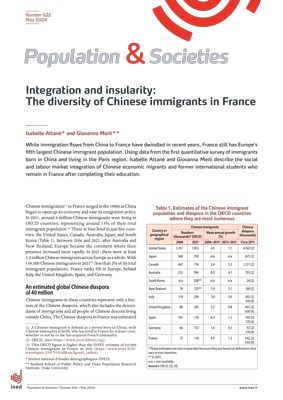Integration and Insularity: The Diversity of Chinese Immigrants in France
Press release Published on 27 May 2024

Authors: Isabelle Attané (Ined) and Giovanna Merli (Sanford School of Public Policy et Duke Population Research Institute, Duke University)
While immigration flows from China are lower today than in the last decades of the 20th century, France still has Europe’s 5th largest Chinese immigrant population. Using data from the first quantitative survey of immigrants born in China and living in the Paris region, Isabelle Attané and Giovanna Merli describe the variety of ways in which they integrate into society and the workplace.
In 2021, France had 116,000 Chinese immigrants. Compared to the end of the last century, growth in the number of Chinese immigrants has sharply decreased, particularly over the last decade. This relative slowdown is due partly to political developments after Xi Jingping became president in 2012. Since that time, the Chinese regime has strengthened its ties with the diaspora and ramped up its policy to encourage return migration. It also reflects a certain disenchantment with France among Chinese immigrants, probably linked to tighter restrictions in immigration policy. The number of Chinese nationals holding a first residence permit halved between 2013 and 2021.
A heterogeneous population; insularity to a certain point
The two main groups of Chinese immigrants are former students and economic migrants. Economic migrants reside largely in the Paris region, where they have a strong presence in certain sectors such as restaurants, bar-tobacco shops, and wholesale trade.
In the Paris region, a large majority of Chinese economic migrants come from south-east China, and almost half come from the Wenzhou area. They are generally low-educated, with only 21% reporting that they speak French ‘well’ or ‘very well’. Their social and employment networks are centred around their community of regional or national origin. This cohesion is dominant among natives of Wenzhou, but it is less pronounced among migrants from the north-east whose social networks are more open to immigrants from other regions of China. Chinese economic migrants in the Paris region have a massive presence in the so-called ‘ethnic’ labour market, i.e. their employer and the majority of their colleagues are also Chinese (or the majority of the employees for the business owners), and the language spoken in the workplace is Mandarin or a Chinese dialect. This community cohesion among Wenzhou immigrants is a strength for the development of their businesses.
Former international students have little in common with economic migrants: they are younger, on average, than economic migrants (34 years vs. 49 years), with a larger majority of women (63% vs. 55%), and have a good command of French (84% speak ‘well’ or ‘very well’). They also tend to socialize more widely outside the circle of Chinese-speakers, at work especially.
Far from representing a close-knit and homogeneous group, Chinese immigrants in the Paris region display wide-ranging profiles and social networks.
Published on: 29/05/2024








